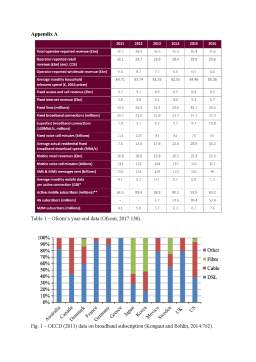Extras din referat
The Policy brief is a short paper intended for a minister that outlines the nature of a contemporary policy issue, problem or opportunity, and presents a brief background of the societal and institutional dynamics of the case. The brief should include the following:
a. The nature of the problem, including a description of those for whom the problem is a problem.
b. The background to the problem, including how the government and other institutions currently act in this field.
c. The key research or data sources already available on the issue.
d. Two or three possible policy options, outlining their strengths and weaknesses.
e. The criteria to be used to judge the success of any future policy development.
Overview
This policy brief is intended for the Minister of State for Digital, the Rt Hon Matt Hancock MP. The aim of this paper is to strongly recommend the Department for Digital, Culture, Media and Sport to create a new network strategy to facilitate long term investments and effective regulations to improve the current telecommunications infrastructure and adopt innovative digital technologies. This brief is particularly concerned by the current digital divide within the UK given by the limited market offer to access superfast and ultrafast broadband connectivity services in rural regions, as supposed to the highly-populated areas, which have benefited from extensive investments in the next generation access (NGA) technology represented mainly by fibre-to-the-cabined (FTTC) and fibre-to-the-premise (FTTP) connections (Gerli et al., 2017). The problem of a limited superfast broadband penetration across the UK is identified by the latest communications market report published by Ofcom (2017), which points out that the nationwide superfast broadband usage as of year-end 2016 (Table 1, Appendix A) had reached a total number of only 10.8 million connections (2015: 9.2 million). Also, the same report indicates that as of November 2016, the average broadband speed in rural areas of England was at 12.2 Mbit/s, whereas the urban average was at 40.0 Mbit/s. This issue represents a key factor that slows down the national economic growth rate and therefore it requires compensatory policy action (Qiang and Rossotto, 2009).
Context and background of the problem
The issue of a limited superfast and ultrafast broadband deployment is also identified by Kongaut and Bohlin (2014) at the international level. In fact, most of the OECD countries and particularly the European Union (EU) are still dominated by the asymmetric digital subscriber line (ADSL) technology, which is less reliable and significantly slower (Fig. 1, Appendix A). This slow adoption rate of high speed networks seen both at the international level and the UK national level is explained by the fact that most of the services within the telecommunication sector are currently governed by market forces, which are primarily concerned about their medium and short term returns on investment, as supposed to offering a socially optimum network distribution for the entire country (Gruber et al., 2014). This concern is also currently addressed by the European Commission (EC) as part of its Digital Agenda (European Commission, 2010:19) that sets the following 2020 targets: (i) all Europeans receive access to superfast broadband connections of above 30 Mbit/s (ii) at least 50% of European households subscribe to internet speeds of above 100 Mbit/s. The policy approach taken by the EC with regards to the deployment of fibre-to-the-building (FTTB) and fibre-to-the-home (FTTH) networks relies on the cost-based access regulation. However, significant research findings indicate that this approach can be ineffective because it does not provide enough incentives for long-term investments in the next generation networks (Briglauer and Gugler, 2013). Thus, it is necessary to further explore other policy options.
Bibliografie
Briglauer, W. and Gugler, K. (2013). ‘The deployment and penetration of high-speed fiber networks and services: Why are EU member states lagging behind?’. Telecommunications Policy, 37, 819-835.
Department for Digital, Culture, Media & Sport (2014). UK Broadband Impact Study. London: Department for Digital, Culture, Media & Sport, pp.3-10. Available at: https://goo.gl/hBKhzH [Accessed 2 Dec. 2017]
European Commission (2010). A digital agenda for Europe. Brussels: European Commission. Available at: https://goo.gl/sXkS7z [Accessed 3 Dec. 2017].
Forzati, M. and Mattsson, C. (2011). ‘Socio-economic return of FTTH investment in Sweden, a prestudy’. [pdf] Sweeden: Swedish ICT Research, pp. 5-18. Available at: https://goo.gl/Z8EXKh [Accessed 6 Dec. 2017].
Gerli, P., Wainwright, D., & Whalley, J. (2017). ‘Infrastructure investment on the margins of the market: The role of niche infrastructure providers in the UK’. Telecommunications Policy, 41(9), 743-756.
Gruber, H., Hatonen, J., & Koutroumpis, P. (2014). ‘Broadband access in the EU: An assessment of future economic benefits’. Telecommunications Policy, 38, 1046-1058.
Kongaut, C. and Bohlin, E. (2014). ‘Unbundling and infrastructure competition for broadband adoption: Implications for NGA regulation’. Telecommunications Policy, 38(8-9), 760-770.
OECD. (2011). OECD communications outlook 2011. Paris: OECD Publishing. Available at: https://goo.gl/zdT5fM [Accessed 2 Dec. 2017].
Qiang, C. and Rossotto, C. (2009) ‘Economic Impacts of Broadband’, in ‘Information and communication for development 2009: Extending reach and increasing impact’, World Bank.
The Office of Communications (2014). Annual Report and Accounts. London: Ofcom, pp. 110-16. Available at: https://goo.gl/q4hmtU [Accessed 2 Dec. 2017].
The Office of Communications (2017). Communications Market Report. London: Ofcom, pp.110-140. Available at: https://goo.gl/PUrpxT [Accessed 3 Dec. 2017].
UK Government (2013). Broadband Delivery UK. Available at: https://goo.gl/MvrFr4 [Accessed 3 Dec. 2017].
Preview document
Conținut arhivă zip
- King's Business School.doc















